Abstract
Treatment of posthaemorrhagic ventricular dilatation by early repeated cerebrospinal fluid taps was compared with conservative management in a randomised controlled trial of 157 infants in 15 centres. Thirty infants died and six moved abroad before follow up. During the first 14 days after randomisation, the early treatment group had five times more taps, and 12 times more cerebrospinal fluid removed. Infection of the cerebrospinal fluid occurred in seven of the early treated and four of the conservatively managed infants. Of survivors, 62% in both groups ultimately had ventricular shunts. Neurodevelopmental assessment of survivors at 12 months was carried out by a single experienced examiner. Of survivors, 103 (85%) had abnormal neuromotor signs and 88 (73%) had disabilities. There was no detectable benefit of early treatment for children who did not have parenchymal lesions at the time they entered the trial. Nearly all those with parenchymal lesions had neuromotor impairment, but early treatment was associated with a significant reduction in other impairments.
Full text
PDF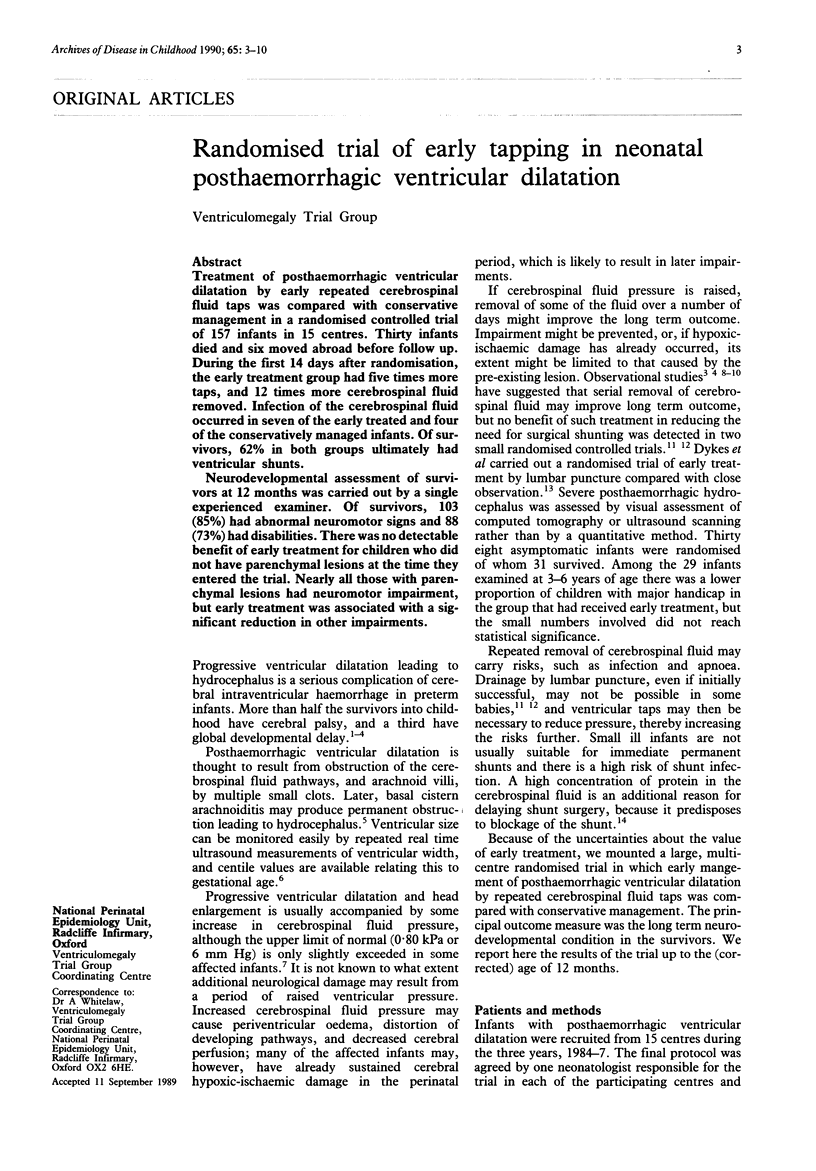
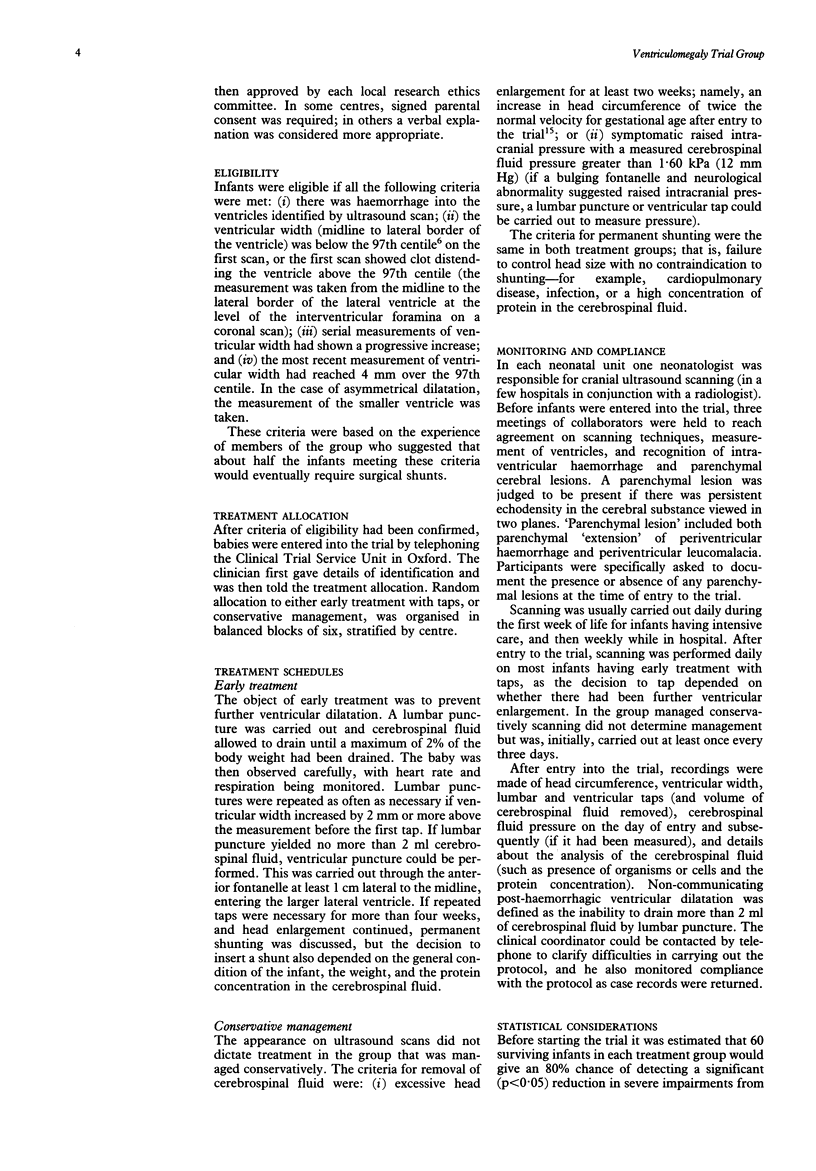

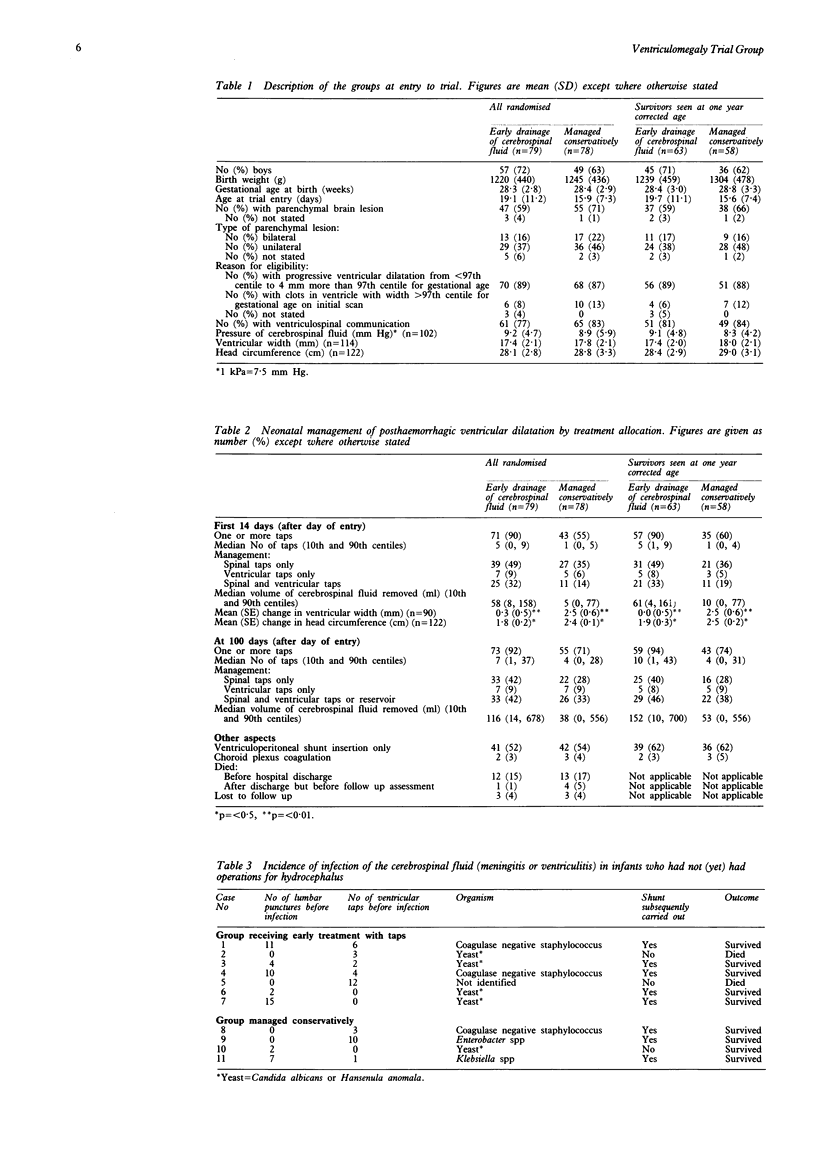
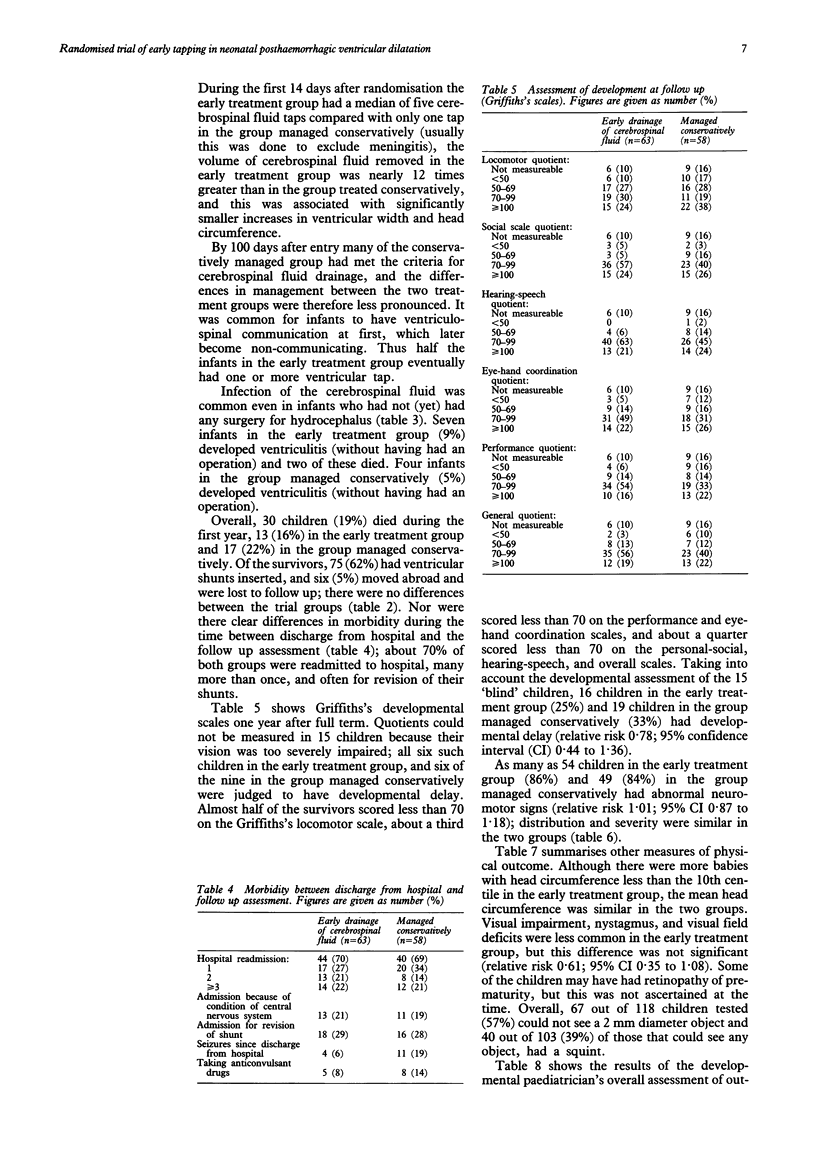
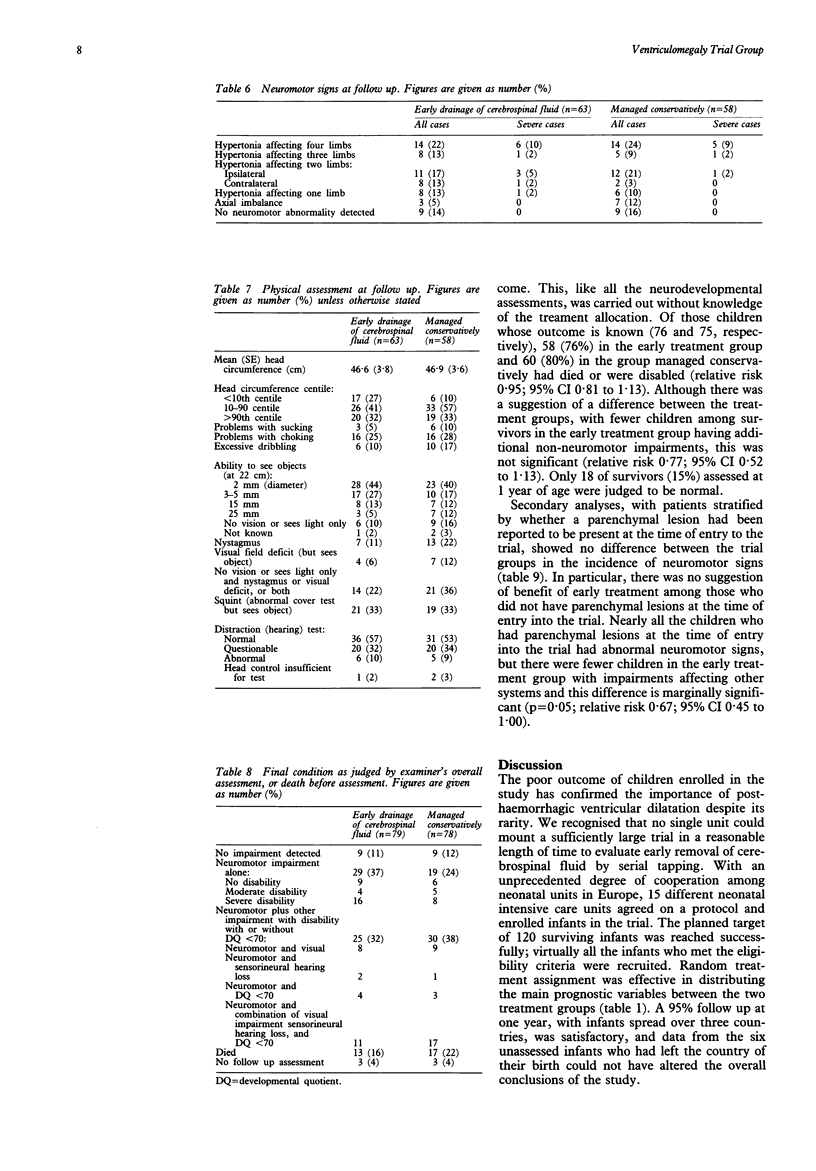
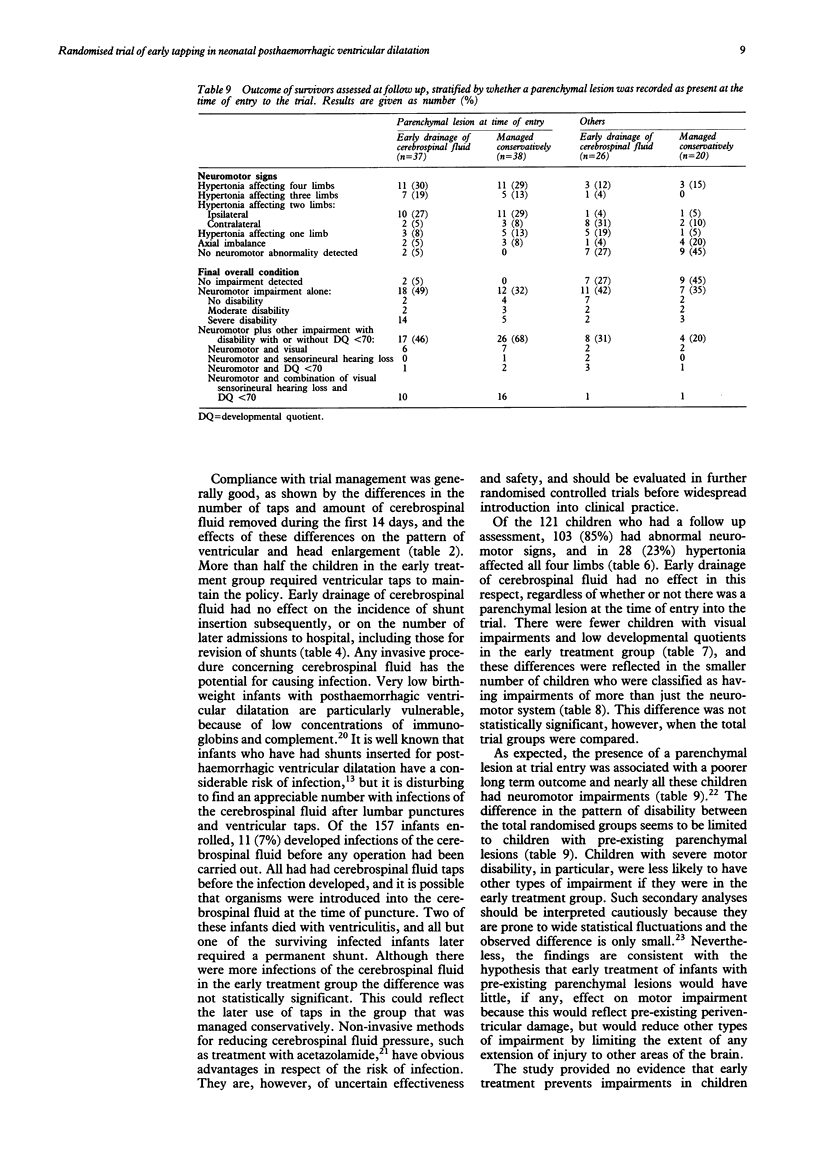
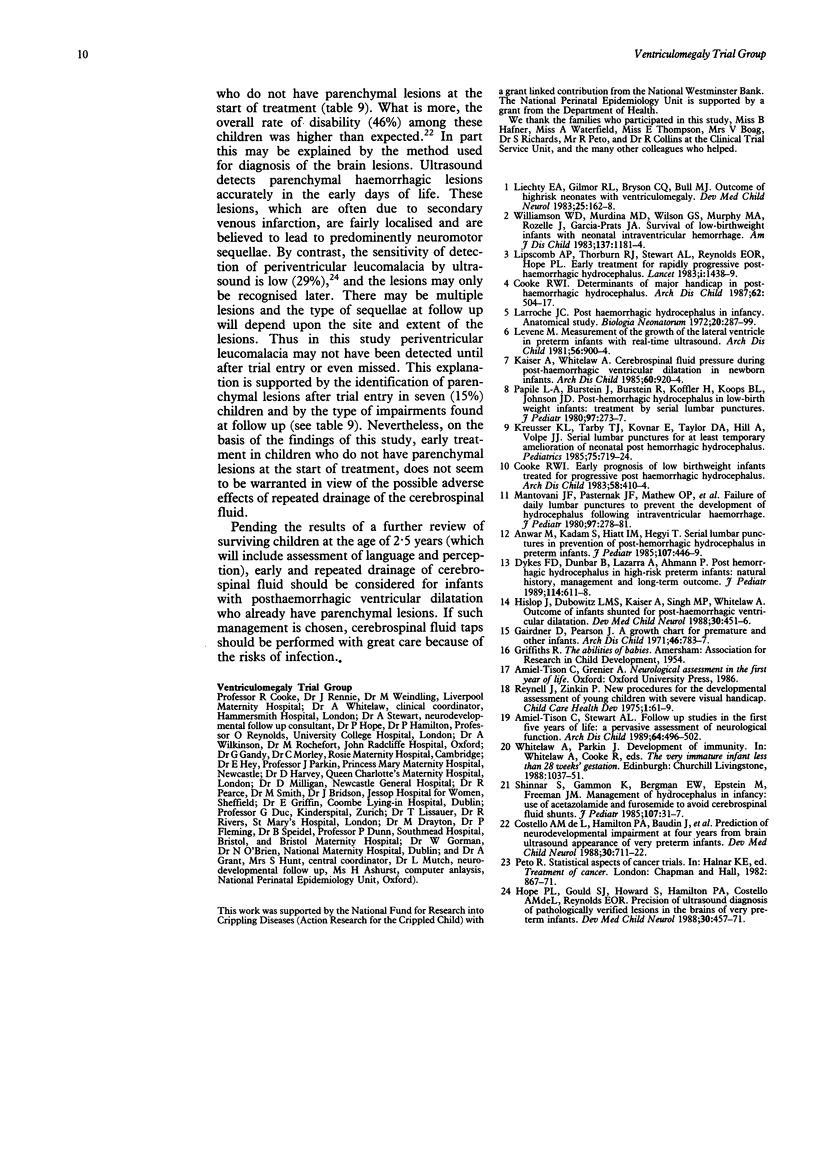
Selected References
These references are in PubMed. This may not be the complete list of references from this article.
- Amiel-Tison C., Stewart A. Follow up studies during the first five years of life: a pervasive assessment of neurological function. Arch Dis Child. 1989 Apr;64(4 Spec No):496–502. doi: 10.1136/adc.64.4_spec_no.496. [DOI] [PMC free article] [PubMed] [Google Scholar]
- Anwar M., Kadam S., Hiatt I. M., Hegyi T. Serial lumbar punctures in prevention of post-hemorrhagic hydrocephalus in preterm infants. J Pediatr. 1985 Sep;107(3):446–450. doi: 10.1016/s0022-3476(85)80532-1. [DOI] [PubMed] [Google Scholar]
- Cooke R. W. Determinants of major handicap in post-haemorrhagic hydrocephalus. Arch Dis Child. 1987 May;62(5):504–506. doi: 10.1136/adc.62.5.504. [DOI] [PMC free article] [PubMed] [Google Scholar]
- Cooke R. W. Early prognosis of low birthweight infants treated for progressive posthaemorrhagic hydrocephalus. Arch Dis Child. 1983 Jun;58(6):410–414. doi: 10.1136/adc.58.6.410. [DOI] [PMC free article] [PubMed] [Google Scholar]
- Costello A. M., Hamilton P. A., Baudin J., Townsend J., Bradford B. C., Stewart A. L., Reynolds E. O. Prediction of neurodevelopmental impairment at four years from brain ultrasound appearance of very preterm infants. Dev Med Child Neurol. 1988 Dec;30(6):711–722. doi: 10.1111/j.1469-8749.1988.tb14633.x. [DOI] [PubMed] [Google Scholar]
- Gairdner D., Pearson J. A growth chart for premature and other infants. Arch Dis Child. 1971 Dec;46(250):783–787. doi: 10.1136/adc.46.250.783. [DOI] [PMC free article] [PubMed] [Google Scholar]
- Hislop J. E., Dubowitz L. M., Kaiser A. M., Singh M. P., Whitelaw A. G. Outcome of infants shunted for post-haemorrhagic ventricular dilatation. Dev Med Child Neurol. 1988 Aug;30(4):451–456. doi: 10.1111/j.1469-8749.1988.tb04772.x. [DOI] [PubMed] [Google Scholar]
- Hope P. L., Gould S. J., Howard S., Hamilton P. A., Costello A. M., Reynolds E. O. Precision of ultrasound diagnosis of pathologically verified lesions in the brains of very preterm infants. Dev Med Child Neurol. 1988 Aug;30(4):457–471. doi: 10.1111/j.1469-8749.1988.tb04773.x. [DOI] [PubMed] [Google Scholar]
- Kaiser A. M., Whitelaw A. G. Cerebrospinal fluid pressure during post haemorrhagic ventricular dilatation in newborn infants. Arch Dis Child. 1985 Oct;60(10):920–924. doi: 10.1136/adc.60.10.920. [DOI] [PMC free article] [PubMed] [Google Scholar]
- Kreusser K. L., Tarby T. J., Kovnar E., Taylor D. A., Hill A., Volpe J. J. Serial lumbar punctures for at least temporary amelioration of neonatal posthemorrhagic hydrocephalus. Pediatrics. 1985 Apr;75(4):719–724. [PubMed] [Google Scholar]
- Larroche J. C. Post-haemorrhagic hydrocephalus in infancy. Anatomical study. Biol Neonate. 1972;20(3):287–299. doi: 10.1159/000240472. [DOI] [PubMed] [Google Scholar]
- Levene M. I. Measurement of the growth of the lateral ventricles in preterm infants with real-time ultrasound. Arch Dis Child. 1981 Dec;56(12):900–904. doi: 10.1136/adc.56.12.900. [DOI] [PMC free article] [PubMed] [Google Scholar]
- Liechty E. A., Gilmor R. L., Bryson C. Q., Bull M. J. Outcome of high-risk neonates with ventriculomegaly. Dev Med Child Neurol. 1983 Apr;25(2):162–168. doi: 10.1111/j.1469-8749.1983.tb13739.x. [DOI] [PubMed] [Google Scholar]
- Lipscomb A. P., Thorburn R. J., Stewart A. L., Reynolds E. O., Hope P. L. Early treatment for rapidly progressive post-haemorrhagic hydrocephalus. Lancet. 1983 Jun 25;1(8339):1438–1439. doi: 10.1016/s0140-6736(83)92379-6. [DOI] [PubMed] [Google Scholar]
- Mantovani J. F., Pasternak J. F., Mathew O. P., Allan W. C., Mills M. T., Casper J., Volpe J. J. Failure of daily lumbar punctures to prevent the development of hydrocephalus following intraventricular hemorrhage. J Pediatr. 1980 Aug;97(2):278–281. doi: 10.1016/s0022-3476(80)80495-1. [DOI] [PubMed] [Google Scholar]
- Papile L. A., Burstein J., Burstein R., Koffler H., Koops B. L., Johnson J. D. Posthemorrhagic hydrocephalus in low-birth-weight infants: treatment by serial lumbar punctures. J Pediatr. 1980 Aug;97(2):273–277. doi: 10.1016/s0022-3476(80)80494-x. [DOI] [PubMed] [Google Scholar]
- Williamson W. D., Desmond M. M., Wilson G. S., Murphy M. A., Rozelle J., Garcia-Prats J. A. Survival of low-birth-weight infants with neonatal intraventricular hemorrhage. Outcome in the preschool years. Am J Dis Child. 1983 Dec;137(12):1181–1184. doi: 10.1001/archpedi.1983.02140380041014. [DOI] [PubMed] [Google Scholar]


